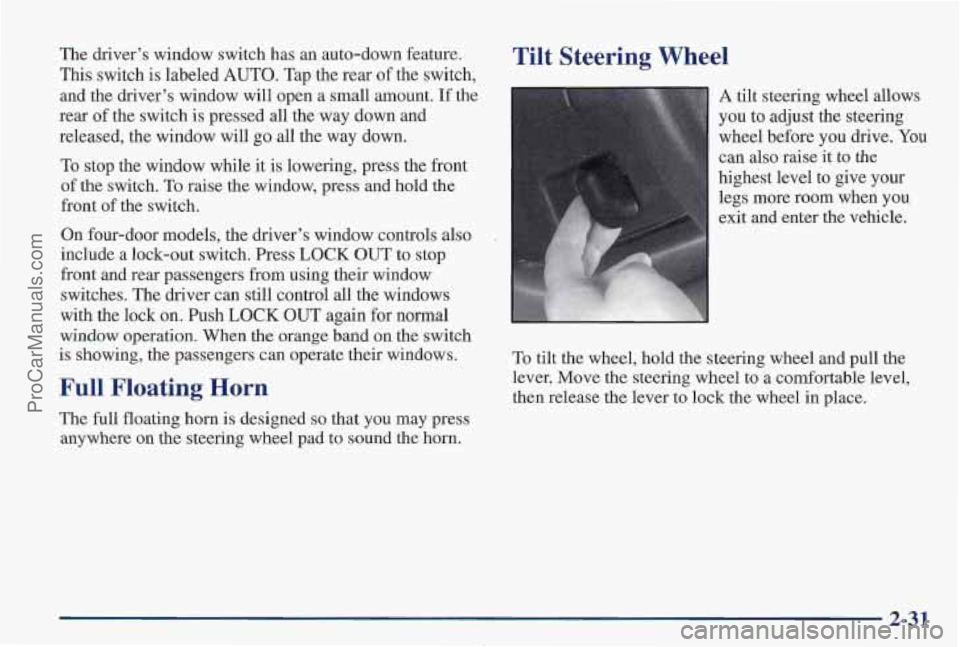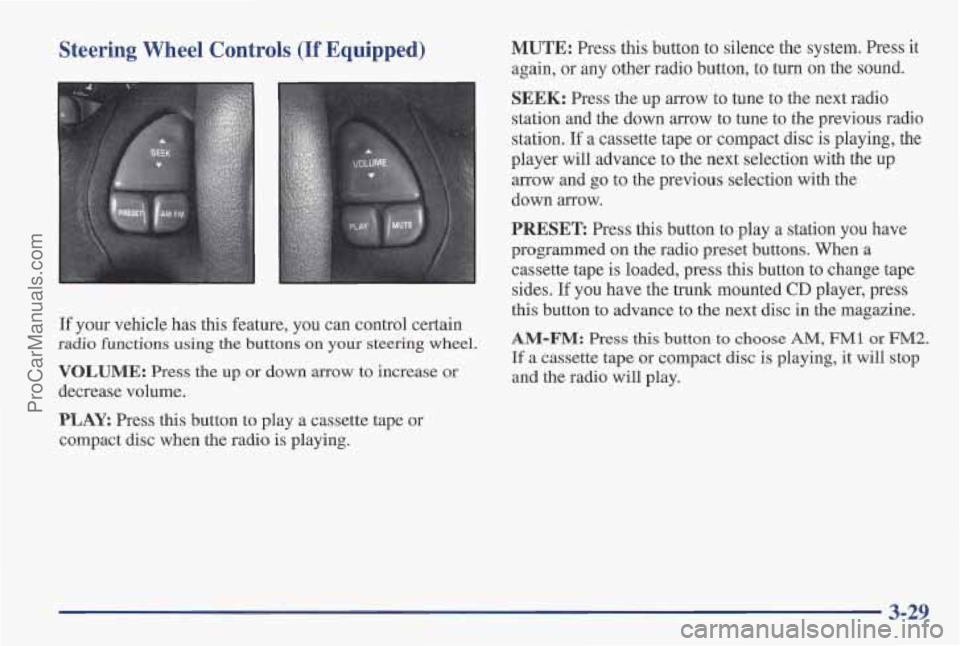Page 93 of 419

Automatic Transaxle Operation
Your automatic transaxle may have a shift lever on the
steering column
or on the console between the seats.
Maximum engine speed is limited when you’re in
PARK (P) or NEUTRAL (N), to protect driveline
components from improper operation. There
are several different positions for your shift lever.
PARK (P): This locks your front wheels. It’s the best
position to use when you start your engine because your
vehicle can’t move easily.
I
It is dangerous to get out of your vehicle if the
shift lever is not fully in PARK (P) with the
parking brake firmly set. Your vehicle can roll.
Don’t leave your vehicle when the engine is
running unless you have to.
If you have left the
engine running, the vehicle can move suddenly.
You or others could be injured.
To be sure your
vehicle won’t move, even when you’re
on fairly
level ground, always set your parking brake and
move the shift lever to
PARK (P).
See “Shifting Into PARK (P)” in the Index. If
you’re pulling
a trailer, see “Towing a Trailer” in
the Index.
ProCarManuals.com
Page 96 of 419

FIRST (1): This position gives you even more power,
but lower fuel economy than
SECOND (2). You can use
it on very steep hills, or in deep snow or mud. If the shift
lever
is put in FIRST (1)’ the transaxle won’t shift into
first gear until the vehicle is going slowly enough.
NOTICE:
~~~~~~ ~
If your front wheels can’t rotate, don’t try to
drive. This might happen if you were stuck in
very deep sand or mud or were up against a solid
object. You could damage your transaxle.
Also, if you stop when going uphill, don’t hold
your vehicle there with only the accelerator
pedal. This could overheat and damage the
transaxle. Use
your brakes or shift into PARK (P)
to hold your vehicle in position on a hill.
Shift Lock Release (Console Shift)
If your vehicle’s battery should go dead, there are two override
access slots that will allow you to override
park lock.
The first is located
underneath the steering
column below the lock
cylinder.
To use this slot,
first remove the trim
cap.
Insert a key or screwdriver
into the access slot and
press
the lock cylinder.
You will now be able to remove your key from the
ignition. Be sure
to replace the trim cap after use.
If the car has a column mounted gear shift lever,
you will now also
be able to shift your vehicle out
of PARK (P).
2-22
ProCarManuals.com
Page 105 of 419

The driver’s window switch has an auto-down feature.
This switch
is labeled AUTO. Tap the rear of the switch,
and the driver’s window will open a small amount. If the
rear of the switch is pressed all the way down and
released, the window will go all the way down.
To stop the window while it
is lowering, press the front
of the switch.
To raise the window, press and hold the
front of the switch.
On four-door models, the driver’s window controls also
include a lock-out switch. Press
LOCK OUT to stop
front and rear passengers from using their window
switches. The driver can still control all the windows
with the lock
on. Push LOCK OUT again for normal
window operation. When the orange band on the switch
is showing, the passengers can operate their windows.
Full Floating Horn
The full floating horn is designed so that you may press
anywhere on the steering wheel pad
to sound the horn.
Tilt Steering Wheel
A tilt steering wheel allows
you to adjust the steering
wheel before
you drive. You
can also raise it to
the
highest level to give your
legs more room when you
exit and enter
the vehicle.
To tilt the wheel, hold the steering wheel and pull
the
lever. Move the steering wheel to a comfortable level,
then release the lever to lock the wheel in place.
2-31
ProCarManuals.com
Page 106 of 419

Wm Signal/Multifunction Lever
1
I
Turn Signal and Lane Change Indicator
The turn signal has two upward (for right) and two
downward (for left) positions. These positions allow
you
to signal a turn or a lane change.
To signal a
turn, move the lever all the way up or down.
When
the turn is finished, the lever will return automatically.
The lever
on the left side of the steering column
includes your:
Turn Signal and Lane Change Indicator
0 Headlamp High/Low Beam
0 Windshield Wipers
Windshield Washer
Cruise Control (If Equipped)
c:
I
An arrow on the instrument
panel will flash in the
direction of the turn or
lane change.
To signal
a lane change, just raise or lower the lever
until the arrow starts to flash. Hold it there until
you
complete your lane change. The lever will return by
itself when you release it.
As you signal a turn or a lane change, if the arrow
flashes faster than normal,
a signal bulb may be burned
out and other drivers won’t see your turn signal.
2-32
ProCarManuals.com
Page 112 of 419

Passing Another Vehicle While Using Cruise Control
Use the accelerator pedal to increase your speed. When
you take your foot off the pedal,
your vehicle will slow
down to the cruise control speed
you set earlier.
Using Cruise Control on Hills
How well your cruise control will work on hills depends
upon your speed, load and the steepness of the hills.
When going up steep hills,
you may have to step on the
accelerator pedal to maintain
your speed. When going
downhill, you may have to brake or shift
to a lower gear
to keep your speed down.
Of course, applying the brake
takes you out of cruise control, Many drivers find this to
be too much trouble and don't use cruise control on
steep hills.
Ending Cruise Control
There are two ways to turn off the cruise control:
Step lightly on the brake pedal; OR
Move the cruise switch to OFF.
Erasing Cruise Speed Memory
When you turn off the cruise control or the ignition, or
shift into
PARK (P) or NEUTRAL (N), your cruise
control set speed memory is erased.
Lamps
The lamp controls are located on the lower, left side of
the instrument panel, to the left
of the steering wheel.
They control these systems:
Headlamps
@ Taillamps
Parking Lamps
License Lamps
0 Sidemarker Lamps
0 Instrument Panel Lights
0 Courtesy Lamps
0 Fo'g Lamps
2-38
ProCarManuals.com
Page 158 of 419

The HUD will display the “Check Gage” when the
following are lit on the instrument panel:
Oil warning Symbol
0 Coolant Temperature Symbol
0 Charging System Symbol
When you sit straight in your seat, the HUD image will
appear straight ahead near the front bumper.
When
the ignition key is turned to RUN, the HUD
image will come on. Then the Head-Up Display will
operate normally.
NOTICE:
Although the HUD image appears to be near the
front
of the vehicle, do not use it as a parking aid.
The
HUD was not designed for that purpose.
If you try to use it that way, such as in a
parking lot, you may misjudge distance and
run into something.
When the HUD is on, the speedometer reading will be
displayed continually. The current radio station or
CD
track number will only be displayed for three seconds
after the radio or
CD track status changes. This will
happen whenever one
of the radio controls is pressed,
either on the radio itself or on the optional steering
wheel controls.
...... ............. ... ...... .... . ... 2-84 L ., .5 e--..% _I...-,. I. .. .: . ’ ., , ,. ,.-. - .... ., .. _. .. .. . ,. .
ProCarManuals.com
Page 161 of 419

Section 3 Comfort Controls and Audio Systems
In this section, you'll find out how to operate the comfort control and audio systems offered with your Pontiac. Be
sure to read about the particular systems supplied with your vehicle.
3-2
3-2
3-4
3-4
3-8
3-8
3-8
3-9
3- 10
Comfort Controls
Air Conditioning, Air Conditioning with
Electronic Controls Air Conditioning, Air Conditioning with
Automatic and Auxiliary Temperature Control
Heating, Air Conditioning with
Electronic Controls
Heating, Air Conditioning with Automatic
and Auxiliary Temperature Controls
Ventilation System and Tips
Tips for Defogging and Defrosting
Rear Window Defogger Setting the Clock 3- 10
3-15
3-24
3-26
3-29
3-30 3-30
3-30
3-3 1
3-32
3-32
3-32 Radios
CD Adapter Kit
Trunk Mounted CD Changer
Theft-Deterrent Feature
Steering Wheel Controls
Understanding Radio Reception Adding Sound Equipment to Your
Tips About Your Audio System
Care
of Your Cassette Tape Player
Care of Your Compact Discs
Fixed Mast Antenna
Backglass Antenna
.. :le
ProCarManuals.com
Page 189 of 419

Steering Wheel Controls (If Equipped) MUTE: Press this button to silence the system. Press it
again, or any other radio button, to turn on the sound.
If your vehicle has this feature, you can control certain
radio functions using the buttons on your steering wheel.
VOLUME: Press the up or down arrow to increase or
decrease volume.
PLAY. Press this button to play a cassette tape or
compact disc when the radio is playing.
SEEK: Press the up arrow to tune to the next radio
station and the down arrow to tune to
the previous radio
station.
If a cassette tape or compact disc is playing, the
player will advance to the next selection with the
up
arrow and go to the previous selection with the
down arrow.
PRESET Press this button to play a station you have
programmed
on the radio preset buttons. When a
cassette tape is loaded, press this button to change tape
sides.
If you have the trunk mounted CD player, press
this button to advance to the next disc in the magazine.
AM-FM: Press this button to choose AM, FM1 or FM2.
If a cassette tape or compact disc is playing, it will stop
and the radio will play.
3-29
ProCarManuals.com